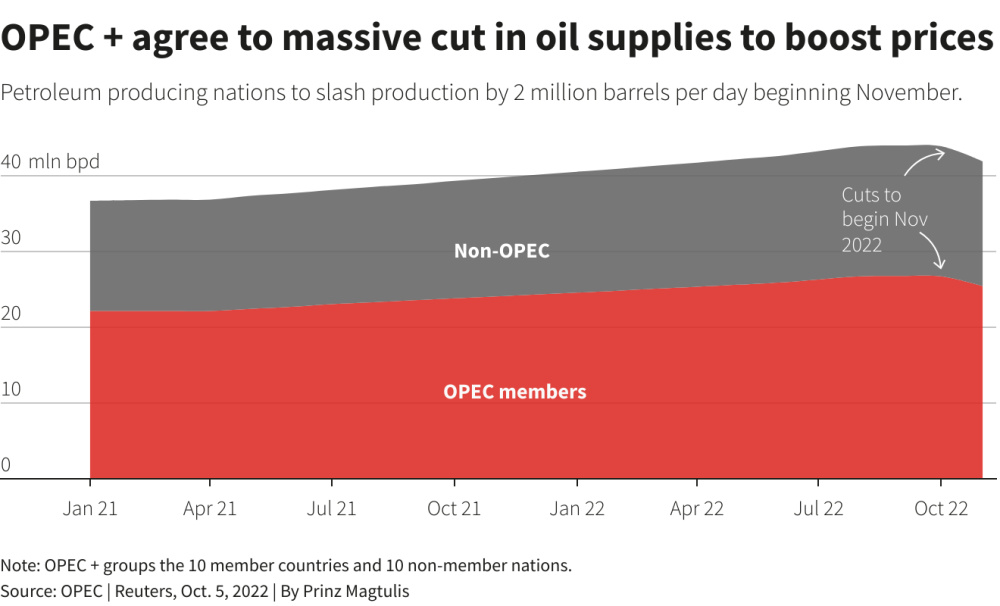OPEC+ surprise deep oil production cuts agreed this week are set to benefit Russia most while tightening supply to the West already suffering from record energy prices.
OPEC+ and the West traded blame on Oct. 5 after the group reduced supply by a steep 2 million bbl/d or 2% of global supply in an already tight market.
OPEC’s leader Saudi Arabia said it was merely reacting to the soaring interest rates in the West where the central banks such as the U.S. Federal Reserve are “belatedly” reducing liquidity, triggering a dollar rise and making oil cheaper.
Washington accused OPEC of siding with Russia and called the decision short-sighted saying the world was already suffering from high energy costs due to Russia’s invasion of Ukraine.
OPEC+ includes 13 members of OPEC and 11 allies led by Russia.

On Oct. 6, oil market watchers said that based on pure maths and OPEC+’s latest production data Russia was indeed set to benefit most from the decision.
Moscow won’t have to reduce a single barrel of output as it is already producing well below the agreed target while benefiting from higher oil price which will be achieved through cuts mainly by OPEC Gulf producers.
“The winner is Russia while the loser is the global consumer who does not need higher energy prices going into an economic slowdown,” said Ole Hansen from Saxo bank.
No Cut for Moscow
The Kremlin said on Oct. 6 the cuts were aimed at market stabilization and confirmed OPEC+'s credentials as an organization responsible for market stability.
The cuts of 2 million bbl/d represent over 4% of OPEC+’s overall target production of 43.8 million.
But the group has already been struggling to produce at targets before the cut, pumping 3.6 million bbl/d short of its output goals in August.
RELATED:
OPEC+ Oil Output Cut Ahead of Winter Fans Inflation Concerns
The main laggards in the past few years have traditionally been Angola and Nigeria due to poor investment.
In recent months, they were joined by Russia, which came under severe Western sanctions following its invasion of Ukraine and was pumping 9.9 million bbl/d in September versus its target of 11 million bbl/d.
Under the deal on Oct. 5, Russia is supposed to reduce its output to 10.5 million bbl/d—essentially 600,000 bbl/d above its current output.
“Russia won’t have to cut anything. It is positive news for Russian oil firms, which will benefit from higher prices while keeping output steady,” said Russia-based BCS Express brokerage.
Who’s Cutting?
By contrast, OPEC’s leader Saudi Arabia, which has been pumping in line with the target will have to cut around 0.5 million of real barrels per day—worth $46 million a day or 1.4 billion a month.
Rystad Energy’s senior vice president Jorge Leon said he estimated 1.2 million bbl/d of effective output cut will be mainly shouldered by Saudi Arabia (-520,000 bbl/d), Iraq (-220,000 bbl/d), the United Arab Emirates (-150,000 bbl/d) and Kuwait (-135,000 bbl/d).
“Higher oil prices will inevitably add to the inflation headache that global central banks are fighting, and higher oil prices will factor into the calculus of further increasing interest rates to cool down the economy,” he said.
Morgan Stanley analysts also said the cuts would tighten oil markets significantly, especially once the EU embargo on Russia oil and refined products comes into force this and next year.
“We now see the oil market nearly 1 million bbl/d undersupplied once again in 2023,” analyst Martijn Rats said.
Russia will likely see a further loss in production while having to accept a deeper discount of the oil sells to Asia.
Hansen said he expected the U.S. Fed to tighten rates further, resulting in a stronger dollar, higher bond yields and a global economic slowdown that may end up taking longer to reverse.
Norbert Rücker from Julius Baer said the tensions between the oil consumers and producers were set to increase.
“The West has more incentives to ease sanctions on pariah states such as Venezuela or Iran. China as an oil consumer looks torn in the middle of the opponents,” he said.
Recommended Reading
Southeast Asia NatGas Projects Could Unlock $100B Boom- Rystad
2024-07-17 - Southeast Asia's offshore gas industry is set for a $100 billion boom by 2028, driven by a flurry of final investment decisions by oil and gas majors and national oil companies, according to Rystad Energy.
E&P Highlights: July 15, 2024
2024-07-15 - Here’s a roundup of the latest E&P headlines, including Freeport LNG’s restart after Hurricane Beryl and ADNOC’s deployment of AI-powered tech at its offshore fields.
Comstock, Aethon’s 17 Western Haynesville Wildcats Make 112 Bcf to Date
2024-08-01 - Comstock Resources and Aethon Energy each added one well to Texas state production data on the new western Haynesville play, dubbed ‘The Waynesville.’ The oldest has surfaced 2.1 Bcf per 1,000 lateral ft to date.
The EPC Market Keeps Its Head Above Water
2024-08-06 - While offshore investments are rising, particularly in deepwater fields, challenges persist due to project delays and inflation, according to Westwood analysis.
US Drillers Cut Oil, Gas Rigs for Fifth Week in Six, Baker Hughes Says
2024-09-20 - U.S. energy firms this week resumed cutting the number of oil and natural gas rigs after adding rigs last week.
Comments
Add new comment
This conversation is moderated according to Hart Energy community rules. Please read the rules before joining the discussion. If you’re experiencing any technical problems, please contact our customer care team.




